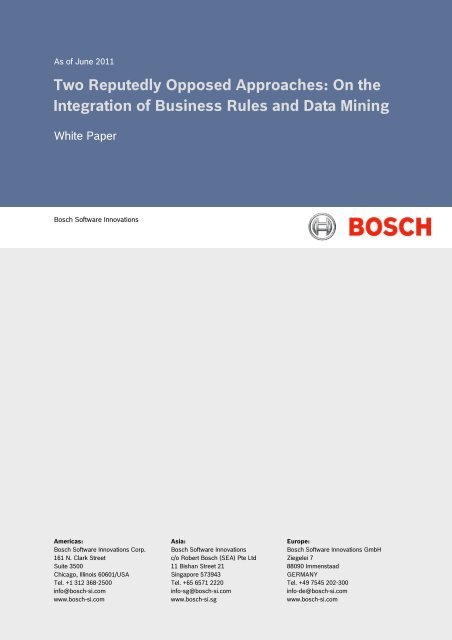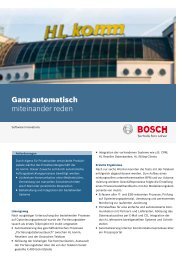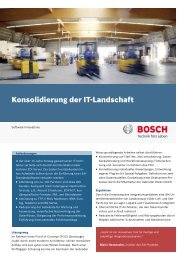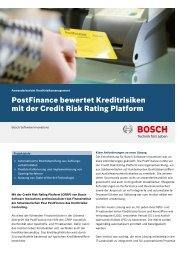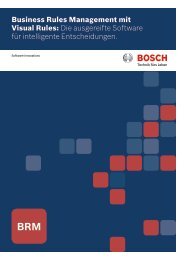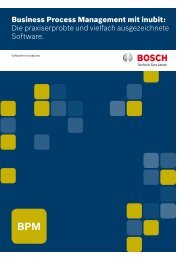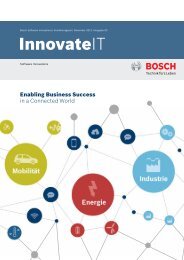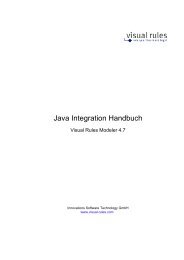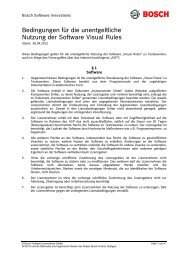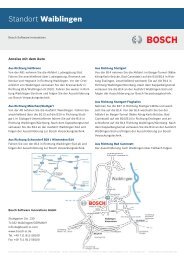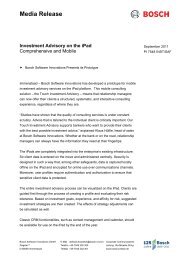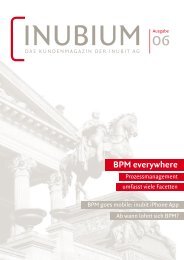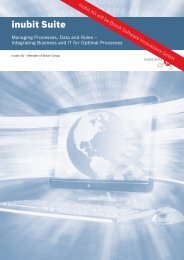Two Reputedly Opposed Approaches: On the Integration of ...
Two Reputedly Opposed Approaches: On the Integration of ...
Two Reputedly Opposed Approaches: On the Integration of ...
Create successful ePaper yourself
Turn your PDF publications into a flip-book with our unique Google optimized e-Paper software.
As <strong>of</strong> June 2011<br />
<strong>Two</strong> <strong>Reputedly</strong> <strong>Opposed</strong> <strong>Approaches</strong>: <strong>On</strong> <strong>the</strong><br />
<strong>Integration</strong> <strong>of</strong> Business Rules and Data Mining<br />
White Paper<br />
Bosch S<strong>of</strong>tware Innovations<br />
Americas:<br />
Bosch S<strong>of</strong>tware Innovations Corp.<br />
161 N. Clark Street<br />
Suite 3500<br />
Chicago, Illinois 60601/USA<br />
Tel. +1 312 368-2500<br />
info@bosch-si.com<br />
www.bosch-si.com<br />
Asia:<br />
Bosch S<strong>of</strong>tware Innovations<br />
c/o Robert Bosch (SEA) Pte Ltd<br />
11 Bishan Street 21<br />
Singapore 573943<br />
Tel. +65 6571 2220<br />
info-sg@bosch-si.com<br />
www.bosch-si.sg<br />
Europe:<br />
Bosch S<strong>of</strong>tware Innovations GmbH<br />
Ziegelei 7<br />
88090 Immenstaad<br />
GERMANY<br />
Tel. +49 7545 202-300<br />
info-de@bosch-si.com<br />
www.bosch-si.com
<strong>Two</strong> <strong>Reputedly</strong> <strong>Opposed</strong> <strong>Approaches</strong>: <strong>On</strong> <strong>the</strong><br />
<strong>Integration</strong> <strong>of</strong> Business Rules and Data Mining<br />
Irene M. Cramer<br />
Business rules and data mining approaches are <strong>of</strong>ten treated as competitors, although<br />
<strong>the</strong>y have differing fields <strong>of</strong> application: While business rules provide a valuable insight<br />
into <strong>the</strong> calculation <strong>of</strong> business parameters and help to trace tacit knowledge,<br />
data mining <strong>of</strong>fers powerful methods for processing large data sets and handling<br />
complex, potentially dynamic feature spaces. In this paper, we show how <strong>the</strong> two disciplines<br />
team up and are used in a direct marketing and a process control scenario.<br />
Content<br />
Introduction<br />
Scenario 1: Direct Marketing<br />
Scenario 2: Process Control<br />
Summary<br />
References<br />
2<br />
3<br />
5<br />
8<br />
9<br />
Introduction<br />
Are you confronted with data in abundance? Are you<br />
undecided how to find out if <strong>the</strong>re is something <strong>of</strong> interest<br />
hidden in your data? Are you looking for relevant<br />
patterns? Combine a business rules and a data mining<br />
approach. Then you can take advantage <strong>of</strong> <strong>the</strong>ir particular<br />
strong points in managing data. In this paper,<br />
we discuss two application scenarios and show you:<br />
- How to use a business rules system to feed a<br />
data mining toolkit with feature vectors<br />
- How to determine reasonable subgroups if you<br />
already know <strong>the</strong> relevant features<br />
- How to determine <strong>the</strong> distinctive features if you<br />
already know <strong>the</strong> relevant subgroups<br />
- How to use <strong>the</strong> results <strong>of</strong> <strong>the</strong> data mining steps<br />
in business rules<br />
This paper is intended to be used as a cookbook: if <strong>the</strong><br />
scenarios, i.e. <strong>the</strong> direct marketing or <strong>the</strong> process control<br />
dishes, are <strong>of</strong> business interest to you, read it as<br />
<strong>the</strong> recipe. If you would like to cook something else,<br />
you can vary <strong>the</strong> ingredients and read this paper as a<br />
description <strong>of</strong> <strong>the</strong> method. If your use case addresses<br />
any subarea <strong>of</strong> data mining not discussed in this paper,<br />
please get in touch. We will be happy to come up<br />
with ano<strong>the</strong>r recipe to fit your particular use case.<br />
The remainder <strong>of</strong> this paper is structured as follows: in<br />
section "Scenario 1: Direct Marketing", we sketch <strong>the</strong><br />
direct marketing scenario and explain how to combine<br />
your business rules with automatically constructed<br />
classifiers. In section "Scenario 2: Process Control",<br />
we sketch <strong>the</strong> process control scenario and discuss<br />
how to explore your data (e.g. in order to test a hypo<strong>the</strong>sis).<br />
In section "Summary" we recapitulate <strong>the</strong> main<br />
steps you need to perform when integrating a data<br />
mining and a business rules approach.<br />
© Bosch S<strong>of</strong>tware Innovations GmbH 2/9
<strong>Two</strong> <strong>Reputedly</strong> <strong>Opposed</strong> <strong>Approaches</strong>: <strong>On</strong> <strong>the</strong> <strong>Integration</strong> <strong>of</strong> Business Rules and Data Mining<br />
Some Terminology<br />
A feature is (<strong>the</strong> value <strong>of</strong>) a variable used to characterize<br />
an object. A feature is said to be distinctive<br />
if it helps to divide a set <strong>of</strong> objects into subgroups.<br />
A feature vector is an n-dimensional vector<br />
<strong>of</strong> feature values which represents an object.<br />
A subgroup is a set <strong>of</strong> objects that are equal (or<br />
similar) with respect to at least one feature. We<br />
call it a class if <strong>the</strong> set is formed by (intellectual)<br />
abstraction. We call it a cluster if <strong>the</strong> set is<br />
formed by similarity (<strong>of</strong> feature vectors).<br />
Data mining means detecting patterns and extracting<br />
<strong>the</strong>m from data. Data mining methods<br />
are used to (automatically) handle large numbers<br />
<strong>of</strong> objects and high-dimensional feature vectors.<br />
It typically involves four classes <strong>of</strong> tasks: clustering,<br />
classification, regression, and association<br />
rule learning. There are also data mining methods<br />
that help to find <strong>the</strong> relevant features or to<br />
explore and visualize <strong>the</strong> data. Popular methods<br />
include correlation analysis, feature selection, or<br />
feature weighting.<br />
Business rules are statements that formalize<br />
some aspects <strong>of</strong> <strong>the</strong> business. They are stated in<br />
natural language sentences, as a graphical model,<br />
or as a ma<strong>the</strong>matical formula. According to<br />
<strong>the</strong> Business Rules Group (Hay, Healy, & Hall,<br />
2000) <strong>the</strong> rules can define or relate business<br />
terms and <strong>the</strong>y can describe constraints or derivations.<br />
Business rules are defined, deployed,<br />
executed, monitored, and maintained by a Business<br />
Rules Management System such as Visual<br />
Rules (see http://www.visual-rules.com/ for details).<br />
Scenario 1: Direct Marketing<br />
Direct marketing is a type <strong>of</strong> advertising that addresses<br />
<strong>the</strong> members <strong>of</strong> a target group (in a potentially<br />
personalized manner) with techniques such as catalog<br />
distribution or promotional letters. In contrast to TV,<br />
newspaper, or radio advertising, direct marketing implies<br />
that <strong>the</strong> response from consumers is traceable<br />
and measurable. In a B2C context, it is typically used<br />
by small and medium enterprises that need to maximize<br />
<strong>the</strong> return on investment given a limited marketing<br />
budget.<br />
From <strong>the</strong> marketers’ point <strong>of</strong> view, direct marketing<br />
involves <strong>the</strong> collection <strong>of</strong> geo-demographic information<br />
and <strong>the</strong> maintenance <strong>of</strong> a customer-centric data warehouse.<br />
The direct responses, in turn, can be used to<br />
refine <strong>the</strong> market segmentation and <strong>the</strong> consumer pr<strong>of</strong>iles.<br />
From <strong>the</strong> consumers’ point <strong>of</strong> view, direct marketing,<br />
that is to say possibly unwanted and irrelevant<br />
solicitations, violates privacy.<br />
The challenge <strong>of</strong> a successful direct marketing campaign<br />
is to:<br />
- Compile high-quality geo-demographic information<br />
and consumer data form various sources<br />
- Carefully segment <strong>the</strong> market and model target<br />
group pr<strong>of</strong>iles<br />
- Construct well-fitting solicitations for different<br />
types <strong>of</strong> target group members<br />
Scenario and Data: Since retaining existing customers<br />
is more cost-effective than acquiring new ones, <strong>the</strong><br />
marketing department <strong>of</strong> a medium-sized online store<br />
is assigned <strong>the</strong> construction <strong>of</strong> a direct marketing<br />
campaign addressing customers that are likely to be<br />
lost in <strong>the</strong> near future. There are several known factors<br />
associated with <strong>the</strong> loss <strong>of</strong> customers (also referred to<br />
as customer attrition), for instance dissatisfaction with<br />
<strong>the</strong> service, price, or support, billing disputes, etc.<br />
The marketers know that customer attrition models can<br />
be calculated with data mining techniques (Au, Li, &<br />
Ma, 2003). However, <strong>the</strong> colleagues in <strong>the</strong> marketing<br />
and sales departments are old hands at customer retention.<br />
The marketers would like to integrate this experience.<br />
So <strong>the</strong>y decide to combine <strong>the</strong> automatically<br />
calculated models with manually constructed rules.<br />
They agree to model customer attrition on <strong>the</strong> basis <strong>of</strong><br />
<strong>the</strong> data stored in <strong>the</strong> company’s data warehouse. This<br />
data consists <strong>of</strong> vectors (see Figure 1) describing <strong>the</strong><br />
customers in terms <strong>of</strong> several features, e.g. gender,<br />
credit rating, <strong>the</strong> socio-economic status <strong>of</strong> <strong>the</strong> customer<br />
and <strong>the</strong> customer’s neighborhood, <strong>the</strong> number <strong>of</strong><br />
purchases in <strong>the</strong> last few months and years, <strong>the</strong> number<br />
<strong>of</strong> complaints and returns, etc.<br />
Figure 1: Customers Represented as Feature Vectors (Extract)<br />
Each customer is also tagged with one <strong>of</strong> four possible<br />
customer ratings: new customer (0), occasional customer<br />
(1), regular customer (2), or key customer (3).<br />
The rating is determined by, among o<strong>the</strong>rs, <strong>the</strong> customer’s<br />
number <strong>of</strong> purchases and <strong>the</strong> amount <strong>of</strong> turnover.<br />
The marketers are recommended to calculate classification<br />
models on <strong>the</strong> basis <strong>of</strong> manually labeled, historic<br />
feature vectors using <strong>the</strong> data mining toolkit KNIME<br />
(see http://www.knime.org/ for details). These models<br />
classify customers as "switchers" or "stayers” and predict<br />
if a customer may be lost in <strong>the</strong> near future. The<br />
marketers thus prepare a fraction <strong>of</strong> <strong>the</strong> previous<br />
year’s data: customers who had been rated regular or<br />
© Bosch S<strong>of</strong>tware Innovations GmbH 3/9
<strong>Two</strong> <strong>Reputedly</strong> <strong>Opposed</strong> <strong>Approaches</strong>: <strong>On</strong> <strong>the</strong> <strong>Integration</strong> <strong>of</strong> Business Rules and Data Mining<br />
key customers in recent years are tagged with a<br />
"switcher"-flag if <strong>the</strong>y did not order for at least six<br />
months last year and did not order this year so far ei<strong>the</strong>r.<br />
<strong>Two</strong> customer retention experts subsequently<br />
revise <strong>the</strong> data and remove all cases <strong>of</strong> doubt.<br />
Approach: Since several features need to be aggregated<br />
and filtered, business rules are modeled with<br />
Visual Rules (see Figure 2), which<br />
- Remove feature vectors with more than 30%<br />
missing values<br />
- Map some <strong>of</strong> <strong>the</strong> fine-grained features into a<br />
coarser-grained range <strong>of</strong> values<br />
- Decompose some <strong>of</strong> <strong>the</strong> features that merge<br />
several aspects relevant for this scenario<br />
Figure 2: Construction <strong>of</strong> Feature Vectors with a Rule Model<br />
(Extract)<br />
The business rules also convert <strong>the</strong> data into <strong>the</strong> required<br />
format. This data is used to train and evaluate<br />
<strong>the</strong> classification models.<br />
Figure 3: Example Process <strong>of</strong> <strong>the</strong> Classification Task (with<br />
KNIME)<br />
Figure 3 shows <strong>the</strong> essential steps in <strong>the</strong> process: first,<br />
<strong>the</strong> data is read (CSV Reader) and partitioned (Partitioning),<br />
i.e. split into training and test sets. Second,<br />
<strong>the</strong> classification model is calculated based on <strong>the</strong><br />
training set (Naïve Bayes Learner). Third, <strong>the</strong> classification<br />
model is used to predict <strong>the</strong> classes <strong>of</strong> <strong>the</strong> test<br />
set objects (Naïve Bayes Predictor). Finally, <strong>the</strong> classification<br />
model is evaluated (Scorer), i.e. for each object<br />
in <strong>the</strong> test set <strong>the</strong> predicted class is compared with<br />
<strong>the</strong> real one (see box "Popular Evaluation Metrics" for<br />
details).<br />
Let us assume that among <strong>the</strong> best-performing classification<br />
models are a naïve Bayes and a decision tree<br />
classifier. (We use <strong>the</strong>m to simplify matters. Without<br />
doubt, <strong>the</strong>re are more sophisticated algorithms; however,<br />
<strong>the</strong>se two are known to perform well for certain<br />
tasks.)<br />
Popular Evaluation Metrics<br />
The performance <strong>of</strong> a classification algorithm is<br />
measured in terms <strong>of</strong> e.g. precision, recall, and<br />
accuracy given a specific confusion matrix.<br />
with <strong>the</strong> confusion matrix (binary case):<br />
actual<br />
value<br />
predicted value<br />
p' n'<br />
© Bosch S<strong>of</strong>tware Innovations GmbH 4/9<br />
p<br />
n<br />
true<br />
negative<br />
false<br />
negative<br />
false<br />
positive<br />
true<br />
positive<br />
The naïve Bayes is known to be simple and fast – and<br />
despite <strong>the</strong> fact that its simplistic design violates basic<br />
statistical assumptions, it <strong>of</strong>ten performs surprisingly<br />
well for real-world problems. Unfortunately, this classification<br />
model is not self-explanatory and its translation<br />
into business rules is difficult. Instead, if <strong>the</strong> marketing<br />
and sales experts have constructed business rules that<br />
in turn represent a classifier, <strong>the</strong> two models can be<br />
combined. That is to say, <strong>the</strong> naïve Bayes model is<br />
used in <strong>the</strong> manually constructed model, i.e. <strong>the</strong> business<br />
rules, via service call. Combining classification<br />
models can significantly increase <strong>the</strong> predictive performance<br />
<strong>of</strong> <strong>the</strong> ensemble. A comprehensive review <strong>of</strong><br />
possible classifier combination methods, <strong>the</strong>ir advantages,<br />
and disadvantages is given in (Tulyakov,<br />
Jaeger, Govindaraju, & Doermann, 2008).<br />
The decision tree requires little data preparation and<br />
can rapidly classify large data sets. Unfortunately, decision<br />
trees sometimes create models that do not generalize<br />
<strong>the</strong> data (also referred to as overfitting). This<br />
problem can be handled e.g. with pruning mechanisms.<br />
Since decision trees are simple to understand<br />
and interpret (Figure 4 shows <strong>the</strong> extract <strong>of</strong> a decision
<strong>Two</strong> <strong>Reputedly</strong> <strong>Opposed</strong> <strong>Approaches</strong>: <strong>On</strong> <strong>the</strong> <strong>Integration</strong> <strong>of</strong> Business Rules and Data Mining<br />
tree calculated on <strong>the</strong> basis <strong>of</strong> <strong>the</strong> direct marketing<br />
feature vectors), <strong>the</strong>y can be combined easily with<br />
business rules that are manually constructed by marketing<br />
and sales experts.<br />
Figure 4: Simplified Example Decision Tree (Calculated with<br />
KNIME) and Corresponding Business Rule (Modeled with<br />
Visual Rules)<br />
Given <strong>the</strong> classification (computed with ei<strong>the</strong>r a classifier<br />
ensemble or a business rule model), <strong>the</strong> potential<br />
switchers can be split into <strong>the</strong> following groups:<br />
1. Key customers who had no billing disputes with<br />
<strong>the</strong> company in recent years were sent a questionnaire<br />
asking for suggestions (e.g. with respect<br />
to customer service, range <strong>of</strong> products,<br />
etc.) and a voucher <strong>of</strong> 20 Euros.<br />
2. Key customers who recently had billing disputes<br />
were sent a promotional letter including a<br />
promotional gift and a voucher <strong>of</strong> 15 Euros.<br />
3. Regular customers were sent a promotional letter<br />
and a voucher <strong>of</strong> 10 Euros<br />
4. Occasional customers were sent a promotional<br />
letter and a voucher <strong>of</strong> 5 Euros.<br />
Discussion: As <strong>the</strong>se two examples illustrate for <strong>the</strong><br />
case <strong>of</strong> a classification task, <strong>the</strong> data mining and business<br />
rules approaches can be combined in various<br />
ways:<br />
- If <strong>the</strong> classification model is simple to interpret<br />
(such as a decision tree, a decision table, or<br />
decision rules), it can be modeled, i.e. reproduced,<br />
as part <strong>of</strong> <strong>the</strong> business rules. In this<br />
case, <strong>the</strong> data mining toolkit helps to find some<br />
<strong>of</strong> <strong>the</strong> classification rules. It also facilitates <strong>the</strong><br />
estimation <strong>of</strong> base-line performance. Never<strong>the</strong>less,<br />
if a classifier is included in manually constructed<br />
business rules, <strong>the</strong> performance <strong>of</strong> <strong>the</strong><br />
latter can be worse than <strong>the</strong> performance calculated<br />
by <strong>the</strong> data mining toolkit. In this case,<br />
<strong>the</strong> business rules need to be evaluated carefully<br />
(see box "Popular Evaluation Metrics"),<br />
even though <strong>the</strong> modeler was a domain expert.<br />
- If <strong>the</strong> classification model is not simple to interpret<br />
(such as a naïve Bayes, a support vector<br />
machine, or a reasonably complex neural<br />
network), it can be included in <strong>the</strong> business<br />
rules as a service call. In this case, <strong>the</strong> classification<br />
model constructed via data mining toolkit<br />
and <strong>the</strong> business rules function as a classifier<br />
ensemble. Such an ensemble needs to be evaluated<br />
just as carefully as <strong>the</strong> classifierbusiness-rules<br />
combination mentioned above.<br />
What is <strong>the</strong> use <strong>of</strong> this combination? Data mining<br />
techniques have demonstrated high performance in<br />
several real-world applications. As mentioned above,<br />
<strong>the</strong>y are able to handle large data sets and complex,<br />
high-dimensional feature spaces. Admittedly, automatically<br />
computed classification models do not necessarily<br />
provide a (comprehensible) insight into <strong>the</strong> relevant<br />
classification parameters. This is why some people are<br />
skeptical towards <strong>the</strong>se data mining methods. Business<br />
rules, on <strong>the</strong> o<strong>the</strong>r hand, are as highperformance<br />
as data mining (though not necessarily in<br />
<strong>the</strong> same fields <strong>of</strong> application) and in most cases easier<br />
to understand. Moreover, if business requirements<br />
change fast and frequently, business rules are extremely<br />
valuable because <strong>the</strong>y are modeled by experts<br />
who best understand <strong>the</strong> requirements and know how<br />
to access and incorporate tacit knowledge. Combining<br />
both in a classification task <strong>the</strong>n generates a most<br />
welcome synergy effect.<br />
Scenario 2: Process Control<br />
Process control is an engineering discipline that explores<br />
and describes <strong>the</strong> facilities and methods<br />
needed to keep <strong>the</strong> output <strong>of</strong> a process within a desired<br />
range. It typically involves sensors and actuators.<br />
For example, <strong>the</strong> product flow in a plant is a process<br />
that has a specific, desired outcome. Its actual value is<br />
measured by a flow meter (sensor), whereas its desired<br />
value is controlled by <strong>the</strong> setting <strong>of</strong> a valve (actuator).<br />
In most plants <strong>the</strong> sensors and actuators are organized<br />
by what is known as a process control system. It<br />
typically consists <strong>of</strong> <strong>the</strong> field control station, i.e. a component<br />
assembling and managing all sensors and actuators,<br />
and a control room with monitoring and visualization<br />
facilities (see Figure 5). There are different<br />
types <strong>of</strong> control systems for batch and continuous<br />
processes. In this paper we focus on <strong>the</strong> continuous<br />
case, which features smooth, uninterrupted variables<br />
and a continuous flow <strong>of</strong> product. Continuous<br />
processes are used to manufacture very large quantities<br />
<strong>of</strong> e.g. chemicals per year.<br />
© Bosch S<strong>of</strong>tware Innovations GmbH 5/9
<strong>Two</strong> <strong>Reputedly</strong> <strong>Opposed</strong> <strong>Approaches</strong>: <strong>On</strong> <strong>the</strong> <strong>Integration</strong> <strong>of</strong> Business Rules and Data Mining<br />
Figure 5: Example <strong>of</strong> a Control Room (by RobertRED,<br />
http://de.wikipedia.org/wiki/Leitstand retrieved February 9,<br />
2011)<br />
Scenario and Data: Because <strong>of</strong> <strong>the</strong> (always acceptable<br />
but) fluctuating product quality reported by <strong>the</strong><br />
foreman and <strong>the</strong> lab assistants, <strong>the</strong> factory manager <strong>of</strong><br />
a chemical company decides to implement qualityimprovement<br />
activities. Concerning <strong>the</strong> observed fluctuation,<br />
two hypo<strong>the</strong>ses have been established:<br />
1. The quality <strong>of</strong> <strong>the</strong> product depends on <strong>the</strong><br />
quality <strong>of</strong> <strong>the</strong> raw material, which in turn depends<br />
on <strong>the</strong> supplier or transportation chain.<br />
2. The process control <strong>of</strong> one or several plant<br />
components is in need <strong>of</strong> improvement.<br />
The continuous production <strong>of</strong> chemicals in this company’s<br />
plant is managed by a process control system<br />
(e.g. ABB’s Freelance, see<br />
http://www.abb.de/product/us/9AAC115759.aspx<br />
details), which monitors 400 sensors and operates 200<br />
actuators. The sensors measure temperature, pressure,<br />
flow rate, fill level, and pH-value at <strong>the</strong> various<br />
plant components. The settings <strong>of</strong> <strong>the</strong> actuators, i.e.<br />
<strong>the</strong> valves, determine <strong>the</strong> flow rate <strong>of</strong> <strong>the</strong> ingredients<br />
and hence <strong>the</strong> production rate in <strong>the</strong> process steps.<br />
Every five seconds <strong>the</strong> process control system records<br />
<strong>the</strong> measured values and <strong>the</strong> settings <strong>of</strong> <strong>the</strong> valves.<br />
<strong>On</strong> this basis, it can calculate trend lines and display<br />
<strong>the</strong>m on <strong>the</strong> monitoring facilities in <strong>the</strong> control room.<br />
The data is also archived for five years in case an audit<br />
needs to be conducted. Every four hours <strong>the</strong> lab<br />
assistants test <strong>the</strong> quality <strong>of</strong> <strong>the</strong> final product and<br />
record <strong>the</strong> results in an Excel sheet. In this scenario,<br />
<strong>the</strong>re are three types <strong>of</strong> test values: residual moisture,<br />
particle size, and color scale. The supplier (and transportation<br />
chain) <strong>of</strong> every batch <strong>of</strong> raw material used in<br />
<strong>the</strong> production is logged in an SAP system.<br />
The factory manager and lab assistants decide to<br />
compile data over a period <strong>of</strong> eight weeks. They agree<br />
to use <strong>the</strong> data mining toolkit RapidMiner (see<br />
http://rapid-i.com for details) and to calculate a correlation<br />
analysis. (There are without doubt o<strong>the</strong>r, more<br />
sophisticated algorithms for data exploration. We use<br />
this method to show <strong>the</strong> general idea and to simplify<br />
matters.) Although correlation does not necessarily<br />
imply a causal relationship, it can give a hint as to<br />
which <strong>of</strong> <strong>the</strong> two hypo<strong>the</strong>ses mentioned above should<br />
be investigated fur<strong>the</strong>r.<br />
for<br />
Approach & Results: Because <strong>of</strong> <strong>the</strong> temporal aspect<br />
<strong>of</strong> this scenario, <strong>the</strong> construction <strong>of</strong> feature vectors is<br />
less obvious than in <strong>the</strong> direct marketing case. In addition,<br />
information from various sources (i.e. <strong>the</strong> process<br />
control system, a separate Excel sheet, and an SAP<br />
system) needs to be integrated in an appropriate way.<br />
For this reason, <strong>the</strong> approach <strong>of</strong> a sliding window is<br />
employed. The window size is set to four hours, since<br />
every four hours <strong>the</strong> lab assistants test <strong>the</strong> quality <strong>of</strong><br />
<strong>the</strong> final product. The sensor values and <strong>the</strong> actuator<br />
settings are averaged over this period in order to decrease<br />
data dimensions and reduce noise. Business<br />
rules are modeled that construct <strong>the</strong> feature vectors as<br />
follows:<br />
For every set <strong>of</strong> quality test results in <strong>the</strong> Excel sheet,<br />
- Read <strong>the</strong> values <strong>of</strong> <strong>the</strong> 400 sensors and <strong>the</strong><br />
settings <strong>of</strong> <strong>the</strong> 200 actuators <strong>of</strong> <strong>the</strong> past four<br />
hours from <strong>the</strong> process control system<br />
- For every sensor (actuator), average <strong>the</strong> values<br />
(settings) over this period, i.e. calculate <strong>the</strong><br />
mean and variance (see box for details)<br />
- Determine <strong>the</strong> supplier and transportation chain<br />
on <strong>the</strong> basis <strong>of</strong> <strong>the</strong> setting <strong>of</strong> <strong>the</strong> storage tank<br />
valves, <strong>the</strong> rate <strong>of</strong> production, and <strong>the</strong> code<br />
numbers recorded in <strong>the</strong> SAP system<br />
Why Mean and Variance?<br />
The arithmetic mean represents <strong>the</strong> central tendency<br />
(or average) <strong>of</strong> <strong>the</strong> 2880 values (i.e. 12<br />
values per minute x 240 minutes = 2880) per<br />
sensor or actuator. It condenses <strong>the</strong> temporal<br />
dimension into one feature value instead <strong>of</strong> about<br />
3000 and thus simplifies <strong>the</strong> hypo<strong>the</strong>sis testing.<br />
However, <strong>the</strong> arithmetic mean is known to be<br />
sensitive to outliers and does not always<br />
represent uneven or skewed distributions adequately.<br />
For instance, <strong>the</strong> values <strong>of</strong> two fourhours<br />
periods featuring <strong>the</strong> same mean can vary<br />
significantly: let us assume that in <strong>the</strong> first period<br />
many <strong>of</strong> <strong>the</strong> values spread out far from each o<strong>the</strong>r,<br />
while in <strong>the</strong> second one most lie next to <strong>the</strong><br />
mean. Hence, an additional statistic is needed<br />
expressing this difference.<br />
The variance is such a statistic. It indicates how<br />
a set <strong>of</strong> values is distributed around <strong>the</strong> mean. In<br />
<strong>the</strong> case <strong>of</strong> <strong>the</strong> two four-hours periods mentioned<br />
above <strong>the</strong> variances differ while <strong>the</strong> means<br />
equal. This suggests that in <strong>the</strong> first period <strong>the</strong><br />
production in <strong>the</strong> process step monitored by <strong>the</strong><br />
respective sensor had been labile.<br />
In sum, 336 feature vectors are constructed (i.e. 6 per<br />
day x 7 days a week x 8 weeks = 336) including <strong>the</strong><br />
following features (see Figure 6 as illustration):<br />
© Bosch S<strong>of</strong>tware Innovations GmbH 6/9
<strong>Two</strong> <strong>Reputedly</strong> <strong>Opposed</strong> <strong>Approaches</strong>: <strong>On</strong> <strong>the</strong> <strong>Integration</strong> <strong>of</strong> Business Rules and Data Mining<br />
- 3 quality test values (residual moisture, particle<br />
size, and color scale)<br />
- 800 sensor values (mean and variance for 400<br />
sensors)<br />
- 400 actuator settings (mean and variance for<br />
200 actuators)<br />
- 6 supplier and transportation chain data sets<br />
(each for 3 raw materials)<br />
Figure 6: Process Represented as Feature Vectors (Extract)<br />
Figure 7 shows an extract <strong>of</strong> <strong>the</strong> correlation analysis<br />
calculated with RapidMiner. Many consecutive steps in<br />
a chemical process are <strong>of</strong> course correlated to some<br />
extent; in this context however, <strong>the</strong> correlations between<br />
<strong>the</strong> values <strong>of</strong> <strong>the</strong> sensor-actuator pairs and <strong>the</strong><br />
quality scores are <strong>of</strong> interest. Exploring <strong>the</strong>se correlations<br />
indicates that one <strong>of</strong> <strong>the</strong> quality scores (namely<br />
<strong>the</strong> color scale) is highly correlated with <strong>the</strong> values <strong>of</strong><br />
one <strong>of</strong> <strong>the</strong> sensor-actuator pairs (identifier <strong>of</strong> <strong>the</strong> sensor:<br />
KFP11(1), identifier <strong>of</strong> <strong>the</strong> actuator: KFP11(V)).<br />
Inspection <strong>of</strong> <strong>the</strong> data shows that <strong>the</strong> values <strong>of</strong> <strong>the</strong><br />
KPF11(1) sensor, a flow meter, are gradually rising,<br />
ranging from about 44.5 % valve opening at <strong>the</strong> beginning<br />
to about 45.5 % at <strong>the</strong> end <strong>of</strong> <strong>the</strong> eight weeks. At<br />
<strong>the</strong> same time, <strong>the</strong> color scale values are deteriorating.<br />
KFP11(1) specifies <strong>the</strong> amount <strong>of</strong> cooling water used<br />
for controlled crystallization: <strong>the</strong> higher <strong>the</strong> temperature<br />
<strong>of</strong> <strong>the</strong> product coming from <strong>the</strong> preceding process<br />
step, <strong>the</strong> more cooling water is needed. And <strong>the</strong> higher<br />
<strong>the</strong> temperature at <strong>the</strong> beginning <strong>of</strong> <strong>the</strong> crystallization,<br />
<strong>the</strong> more undesired inclusions are <strong>the</strong>re in <strong>the</strong> product<br />
after crystallization. This directly affects <strong>the</strong> color scale<br />
and hence <strong>the</strong> quality. Although <strong>the</strong> sensor (identifier:<br />
KFT10(4)) <strong>of</strong> <strong>the</strong> preceding process step, which is a<br />
<strong>the</strong>rmometer, registers routine values, <strong>the</strong> amount <strong>of</strong><br />
cooling water rises. The factory manager and <strong>the</strong><br />
foremen <strong>the</strong>refore agree to check <strong>the</strong> sensors <strong>of</strong> <strong>the</strong><br />
whole unit. They find that <strong>the</strong> <strong>the</strong>rmometer in <strong>the</strong><br />
process step preceding KFP11(1) is indeed damaged.<br />
See Figure 8 as illustration.<br />
The pairwise correlation table (see Figure 7) also<br />
shows that none <strong>of</strong> <strong>the</strong> quality scores is more than<br />
moderately correlated with <strong>the</strong> supplier or transportation<br />
chain features. That is to say, <strong>the</strong>re is no evidence<br />
supporting <strong>the</strong> first hypo<strong>the</strong>sis mentioned above, i.e.<br />
<strong>the</strong> quality <strong>of</strong> <strong>the</strong> product does not seem to depend on<br />
<strong>the</strong> quality <strong>of</strong> <strong>the</strong> raw material.<br />
Figure 7: Results <strong>of</strong> <strong>the</strong> Correlation Analysis Calculated with<br />
RapidMiner (Extract)<br />
Figure 8: Correlated Values Indicating Damaged Sensor<br />
Figure 9 shows an overview <strong>of</strong> <strong>the</strong> features, <strong>the</strong>ir<br />
range, and fur<strong>the</strong>r statistics. It illustrates that <strong>the</strong> variance<br />
<strong>of</strong> <strong>the</strong> KFT17(3) sensor scatters much more<br />
than <strong>the</strong> variance <strong>of</strong> all <strong>the</strong> o<strong>the</strong>r sensors. Inspection <strong>of</strong><br />
<strong>the</strong> data shows an interesting pattern <strong>of</strong> <strong>the</strong> KFT17<br />
sensor-actuator pair. (Note that this sensor-actuator<br />
pair includes a sensor with <strong>the</strong> identifier KFT17(3) and<br />
an actuator with <strong>the</strong> identifier KFT17(V)). Whenever<br />
<strong>the</strong> variance <strong>of</strong> KFT17(3) strongly scatters, <strong>the</strong> particle<br />
size rises, i.e. <strong>the</strong> quality <strong>of</strong> <strong>the</strong> product suffers. Fur<strong>the</strong>r<br />
investigation reveals that every time <strong>the</strong> process is<br />
restarted KFT17(V) oscillates wildly until it reaches <strong>the</strong><br />
optimal setting (see Figure 10). This causes <strong>the</strong> observed<br />
variance pattern, which corroborates <strong>the</strong><br />
second hypo<strong>the</strong>sis mentioned above, i.e. <strong>the</strong> process<br />
control <strong>of</strong> this unit is in need <strong>of</strong> improvement.<br />
Figure 9: Overview <strong>of</strong> <strong>the</strong> Features incl. Statistics (Extract)<br />
After this eight-week experiment, <strong>the</strong> factory manager,<br />
<strong>the</strong> foremen, and <strong>the</strong> lab assistants agree to model<br />
business rules which constantly examine <strong>the</strong> sensor<br />
and actuator values. The rules, for instance, crosscheck<br />
<strong>the</strong> values registered by <strong>the</strong> sensors (i.e. flow<br />
meters) in consecutive units. Moreover, <strong>the</strong>y automatically<br />
search for uncommon patterns, such as <strong>the</strong> oscillating<br />
valve opening in Figure 10.<br />
© Bosch S<strong>of</strong>tware Innovations GmbH 7/9
<strong>Two</strong> <strong>Reputedly</strong> <strong>Opposed</strong> <strong>Approaches</strong>: <strong>On</strong> <strong>the</strong> <strong>Integration</strong> <strong>of</strong> Business Rules and Data Mining<br />
Figure 10: Opening <strong>of</strong> KFT17(V) Valve after Process Restart<br />
In order to fur<strong>the</strong>r improve <strong>the</strong> process and track quality<br />
issues, <strong>the</strong> rules also continuously<br />
sample feature<br />
vectors with (a) optimal/near<br />
optimal and (b) poor quality<br />
test values. These can be<br />
inspected e.g. every four to<br />
six months by a team <strong>of</strong><br />
quality experts. See Figure<br />
11 as an illustration.<br />
Although <strong>the</strong> process control<br />
system could in principle<br />
conduct <strong>the</strong>se consistency<br />
checks (at least in part) and<br />
sample <strong>the</strong> feature vectors,<br />
using business rules makes<br />
it possible to promptly run<br />
customized tests: if, for instance,<br />
<strong>the</strong> foremen decide<br />
to check a specific unit or<br />
process step, <strong>the</strong>y are able<br />
to adapt <strong>the</strong> business rules<br />
independently <strong>of</strong> any IT consultants and run <strong>the</strong> experiment<br />
in no time.<br />
Figure 11: Regularly Executed QA Business Rules Model<br />
(Extract)<br />
Discussion: You have <strong>the</strong> impression that exploring<br />
data is poking about in <strong>the</strong> fog? You are right. As <strong>the</strong><br />
process control example stresses, it is much less<br />
straightforward than computing a classifier. But it can<br />
be managed if hypo<strong>the</strong>ses are constructed beforehand.<br />
Given <strong>the</strong>se hypo<strong>the</strong>ses, it is possible to decide<br />
what data mining methods you need to employ, what<br />
you can model in terms <strong>of</strong> business rules, and how to<br />
combine both approaches to <strong>the</strong> best advantage.<br />
Summary<br />
As <strong>the</strong> two scenarios illustrate, business rules and data<br />
mining approaches address two different types <strong>of</strong><br />
tasks: while data mining helps to explore data and find<br />
yet unknown patterns, business rules help to handle<br />
<strong>the</strong> necessary data (pre-/post-) processing steps and<br />
calculate known parameters. Many real-world applica-<br />
Figure 12: <strong>Integration</strong> <strong>of</strong> Business Rules and Data Mining <strong>Approaches</strong> (Process)<br />
tions can pr<strong>of</strong>it from a combination <strong>of</strong> both approaches<br />
as sketched in this paper. See Figure 12 as an illustration<br />
<strong>of</strong> <strong>the</strong> steps involved. If you want to design such a<br />
combination, you need to<br />
- Determine what you know and what you do not<br />
know about your data:<br />
o You can model <strong>the</strong> first in terms <strong>of</strong> business<br />
rules and<br />
o You can compute <strong>the</strong> second with data<br />
mining methods<br />
- Define how to explore <strong>the</strong> data, i.e. which data<br />
mining methods might help you to find <strong>the</strong> relevant<br />
patterns<br />
- Decide how to integrate your business rules<br />
and <strong>the</strong> results <strong>of</strong> <strong>the</strong> data mining steps<br />
Experience shows that you should discuss your specific<br />
use case with both a business rules expert and a<br />
data mining expert. You will <strong>the</strong>n get a feel for what to<br />
model in terms <strong>of</strong> business rules and which data mining<br />
methods to use for data exploration.<br />
© Bosch S<strong>of</strong>tware Innovations GmbH 8/9
<strong>Two</strong> <strong>Reputedly</strong> <strong>Opposed</strong> <strong>Approaches</strong>: <strong>On</strong> <strong>the</strong> <strong>Integration</strong> <strong>of</strong> Business Rules and Data Mining<br />
Acknowledgements<br />
We would like to thank Andreas Müller, Jan Trnka, Dr.<br />
Jürgen Cramer, and Stefan Schacht for <strong>the</strong>ir helpful<br />
comments regarding <strong>the</strong> two scenarios described in<br />
this paper. We would also like to thank Eric Düll for<br />
modeling <strong>the</strong> business rules.<br />
References & S<strong>of</strong>tware<br />
Au, T., Li, S., & Ma, G. (2003). Applying and<br />
Evaluating Models to Predict Customer<br />
Attrition Using Data Mining Techniques.<br />
Journal <strong>of</strong> Comparative International<br />
Management, 6(1).<br />
Hay, D., Healy, K. A., & Hall, J. (2000). Defining<br />
Business Rules - What Are They Really? The<br />
Business Rules Group. Final Report Version<br />
1.3. Retrieved January 11, 2001 from<br />
http://www.businessrulesgroup.org/first_paper<br />
/br01c0.htm.<br />
Tulyakov, S., Jaeger, S., Govindaraju, V., &<br />
Doermann, D. (2008). Review <strong>of</strong> Classifier<br />
Combination Methods. In: S. Marinai & H.<br />
Author<br />
Fujisawa (eds.). Studies in Computational<br />
Intelligence: Machine Learning in Document<br />
Analysis and Recognition, p. 361-386.<br />
All business rules were modeled with <strong>the</strong> business<br />
rules engine Visual Rules. Please refer to<br />
http://www.visual-rules.com/technology.html for details<br />
on its rich features and intuitive usage. If you want to<br />
learn more about modeling business rules and integrating<br />
<strong>the</strong> business rules approach into your architectural<br />
environment, please have a look at <strong>the</strong> following<br />
publications: Full-Power Launch with Your Rules<br />
Project (Javamagazin 5/2010) and Golden Rules: New<br />
and Time-Tested Positions for Rules in S<strong>of</strong>tware Architecture<br />
(JavaSPEKTRUM 5/2010). Both papers are<br />
available in <strong>the</strong> Bosch SI media center (see<br />
http://www.bosch-si.com/media-download.html ). You<br />
also find things that are new and noteworthy in our<br />
technology blog (see http://blog.bosch-si.com/ ).<br />
All machine learning experiments were conducted with<br />
<strong>the</strong> machine learning toolkits KNIME and RapidMiner.<br />
Please refer to http://www.knime.org/ and http://rapidi.com<br />
for details on <strong>the</strong>ir features and several very illustrative<br />
usage examples.<br />
Dr. Irene M. Cramer (irene.cramer@bosch-si.com) holds a Master’s Degree and a PhD in Computational Linguistics.<br />
Before she started to work at Bosch S<strong>of</strong>tware Innovations in 2009, she was a member <strong>of</strong> <strong>the</strong> International<br />
Post-Graduate College "Language Technology and Cognitive Systems" (Saarbrücken/Edinburgh) and worked as<br />
a researcher in <strong>the</strong> AI projects SmartWeb (Saarland University) and HyTex (TU Dortmund University). She has<br />
published various papers and monographs on language technology, data mining, and business rules.<br />
© Bosch S<strong>of</strong>tware Innovations GmbH, 2011. All rights reserved. Dissemination or reproduction <strong>of</strong> this publication or any part <strong>of</strong> it for any purpose<br />
or in any form whatever is not permitted without <strong>the</strong> prior express written consent <strong>of</strong> Bosch S<strong>of</strong>tware Innovations GmbH. Information contained in<br />
this publication may be subject to revision without advance notice. MLDS, Visual Rules and Work Frame Relations are registered trademarks <strong>of</strong><br />
Bosch S<strong>of</strong>tware Innovations GmbH. BOSCH and <strong>the</strong> symbol are registered trademarks <strong>of</strong> Robert Bosch GmbH, Germany. Some <strong>of</strong> <strong>the</strong> product<br />
and company names used in this white paper are trademarks and/or registered trademarks. They are used explicitly for reference purposes and<br />
are, independent <strong>of</strong> marking, property <strong>of</strong> <strong>the</strong>ir respective owners.<br />
© Bosch S<strong>of</strong>tware Innovations GmbH 9/9


